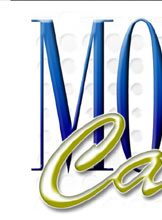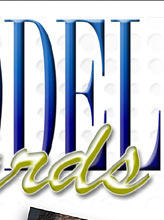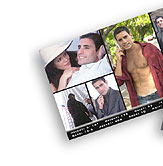



Start with the right photography.
If you look up the word "model" you'll find "to mold and shape" as one of the definitions. That's why the comp cards (zed cards) you hand out shouldn't show-off your photographers skills or even your own beauty. Comp cards should show how good you are at modeling. A good model shows-off the products they're selling without upstaging the product. When a potential buyer (consumer) is looking at the model instead of the product it's called "Vampire Video" - and that's exactly what the client doesn't want.
If you're looking for high fashion photography or runway bookings then you need to put shots that show off your shape so photographers and their clients can see your silhouette. Photographers and designers look for different shapes of figures and different looks so try to mix it up as much as possible without duplicating. Variety is the key.
If you're looking for swim-wear and lingerie bookings make sure that the shots you choose are not too sexy or provocative because they might give the impression that you're in the "adult" industry and consequently might be afraid to recommend you to their client. An advertiser doesn't want their models showing up in the pages of controversial magazines.
And if your someone who has a rubber face and can easily change expressions, that's what you want your comp card to reflect.
Let
the comp card fit the client.
Not all modeling jobs are created equal,
and using one comp card (zed card) to satisfy
all situations may not be the best strategy. If you have a good selection
of photographs you should try to create the right comp card for the right
client. High fashion demands a very particular look, but it's not the
same look as someone who is looking for a friendly face to hold up a carton
of milk or baby food. With today's technology you can print 50 or 500
comp cards. You no longer have to order 1,000 cards at a time. So it's
economical to print 2 or 3 versions of comp cards to fit the situation.
This gives you an edge against other models who only have one card to
show and try to make it work for every circumstance.
Does
the design of your comp card (zed card) matter?
That's like asking do clothes and make-up
and hair style matter. While your comp card (zed card) should show you
off, how your pictures are presented can be the difference of getting
a job or not. Type face, shapes and color can go far in projecting a positive
image and personality. Model Cards prides itself in our ability to create
different looks for our clients and maintaining a higher standard of excellence
in design. Of course many agencies have their own layout that you must
follow as part of your contract with that agency. That's usually not a
bad thing since that agency probably has good recognition.
Your
comp card is only as good as the images you put on them.
This is an obvious statement, but one that
many choose to ignore. You might have an image that you love but the resolution
is too low, or the shot is a little soft but you still love how you look.
Get over it. When a picture is not technically correct it reproduces badly
and make you look like an amateur.
What you need to know about the photography
you submit for you comp cards (zed cards).
Digital Images are the best and easiest
to work. Many photographers now work exclusively with digital cameras
so there's no need to scan a print or transparency. Plus, digital is sharper
because it actually holds more information. Digital images also travel
well across the internet. You'll want your images to be no less than 300
dpi (dots per inch) and sharp. That doesn't mean that you can't have critical
focus where only one section is sharp and the rest of the shot is soft.
It means that where it's supposed to be sharp - it's sharp. You should
know that all printing today is done from digital files, so all images
have to digitized.
Transparencies (slides-negatives & positive) were the standard for
the last 25 years but are now being replaced by digital photography. There's
nothing wrong with transparencies except the extra work of having to turn
them into digital images with scanning and color correcting them which
may be added expenses to you. Also, if you send a transparency for scanning
you will get a different result from almost everyone you give it to. There
are no exact standards for this type of scanning and the only way to judge
is to choose what is pleasing to the eye.
Prints have to be scanned. So, while they are only one generation away
from the original photography they now wind up a second generation away
from the original and thereby are slightly softer. You should avoid having
to scan prints. It isn't a disaster to scan a print, it's just less preferable.
Tear Sheets have the same issues as prints
but have one additional problem. Because they are already printed it means
that they have been reduced to "dots". The printing process
reduces all photography to dots, so if you scan a printed page you can't
look any better than the way it's printed and will probably look worse.
You never loose the second hand "printed" look. The only reason
you might want to use a printed piece is show that you've been published.
Don't
be fooled by your computer screen.
The computer makes images look good at one
quarter of the resolution needed to print. So if you're looking at an
image on your screen at 72 dpi (dots per inch) it will look no different
than an image at 300 dpi because 72 dpi is all your screen can render.
Also the computer screen makes the images look more alive then when printed
because light is coming through the back of the image. When your comp
card is printed it is changed from the 3 colors used by the computer to
render it on the screen to 4 color process (Red, Yellow, Cyan and Black)
which is printed in layers on top of each other. This is why the printed
comp card is never as vibrant as the the image on the computer screen.
This is true to all printing processes.
Don't
make time your enemy.
When you wait for the last minute to get
your comp cards (zed cards) printed you're putting the entire printing
process in jeopardy. Printing is no different from anything else. If you
want a good printing job you must give the people you're hiring to do
their work enough time to do their job. When you rush a job it's easy
to overlook errors in proofing your information. The more time you allow
for pre-production the better chance you have of getting a superb card.
Lastly,
don't let names fool you.
"Comp cards" are also called "zed
cards" or "composite cards". These three terms mean actually
the same thing. In fact the expression "comp card" is a shortened
version of "composite card" while "zed card" is a
term primarily used in the western part of the country.


ARTICLES:
Image Is Everything
1 -
And so is the design of your comp cards.
Image Is Everything
2 -
Tips on producing the best comp card.